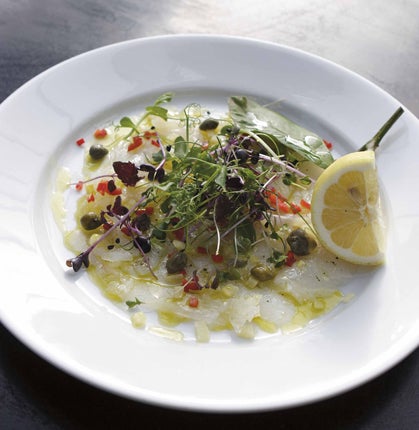Carpaccio of salt cod with preserved lemon, chilli, capers and mixed cress
Serves 2 (as a starter)

Salt cod is a favourite of mine. Whenever I put it on the menu at the restaurant, it walks very quickly out the door. Perhaps this is because in Britain, at least, it is not very often eaten at home. Here, we tend to think of it as complicated, even a little scary. It's a hard, pungent, musty thing that resembles a piece of leather. What on earth are we meant to do with it?
I realise that over-fishing makes cod a potential minefield, but I believe that the cultural value of salt cod makes it worth a risk. Its importance in the culinary traditions of the Basque Country cannot be underestimated. And it's very popular in Iceland, thanks to their sustainable fishing policies.
The Marine Conservation Society recommends choosing line-caught cod from a sustainable stock. Talk to your fish supplier – ask if he stocks line- caught fish, and where it is from.
I have never found shop-bought salt cod satisfactory. Often it can be hard, sinewy and massively over-salted. As a result, I became intrigued by curing the fish myself. The idea that you can take an ingredient in its purest form, and by respectfully manipulating it, turn it into something else, is incredibly gratifying.
Through trial and error I have achieved a cure that is gentle and succulent. In fact, the result is beautiful and delicate enough to serve raw and unrinsed. Slice as finely as smoked salmon, then drizzle with oil, lots of pepper and a squeeze of lemon juice.
How to cure your cod
Ask your fish supplier for a skinned cod fillet. Rinse it under cold water and gently pat it dry using a dishcloth. Weigh the fish and season it all over with 11/2 tablespoons of plain, good-quality sea salt per 500g/1lb of fish. Go over the central section of the fish with a little more salt to ensure that this, the thickest part, also receives an even curing. Now lay the fish on a stainless-steel rack and fit it snugly inside a larger pan (which will catch the drips while the cod is curing).
Loosely cover the whole pan with clingfilm to prevent the smell seeping into the rest of your fridge – home- curing cod is a stinky business.
Refrigerate the pan and let cure for up to seven days. Remove and rinse your bottom pan every day because, as the cod begins to firm, liquid will weep from its body. Your fillet will give off about two tablespoons of liquid per kilogram.
Depending on what I am intending to do with the end result, I only allow the fish to cure for three days. Rinsed and filleted into portions, this home-cured cod is gentle and delicate enough to serve simply grilled with a green sauce or roasted tomatoes and a lemony aioli. If I serve it very finely sliced and raw, three days is also more than enough curing time.
For this dish, I suggest that you cure the salt cod for no more than four days. It does not need to be rinsed; the strong, clean flavours that accompany it more than counterbalance the slight salty flavour. You will need a really sharp knife to slice the cod into beautiful superfine sheets.
You can buy preserved lemons, but it is so easy to do them yourself. Slice the fruits into quarters lengthwise, pack into a sterilised jar and sprinkle with sea salt. Seal tightly with a lid and leave at least 10 days before using—well kept, they will last for up to a year. The salt will transform their flavour from bitter to sour-sweet. Always remember to scrape away the bitter pulp and use only the zest.
Serves 2 (as a starter)
1 salt cod fillet, weighing approximately 2kg/4lb, cured for 4 days
1 red chilli, very finely sliced
1 tbsp capers (the ones packed in salt are so much tastier than the ones in vinegar), rinsed and dried
1/2 preserved lemon (zest only), finely diced
2 tbsp extra-virgin olive oil
The juice of 1/2 a lemon
A small handful of mixed cress
Using a sharp knife, slice the fish as finely as possible. Lay the fish in a single layer on a flat plate and sprinkle over the chilli, capers and diced lemon zest.
To serve, pour the olive oil over the fish, squeeze the lemon juice on top and scatter the cress over everything.
Join our commenting forum
Join thought-provoking conversations, follow other Independent readers and see their replies
Comments